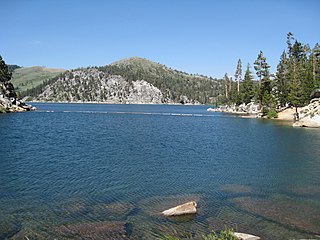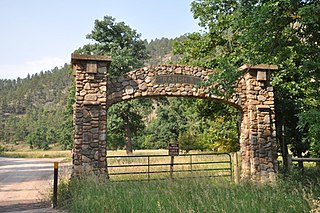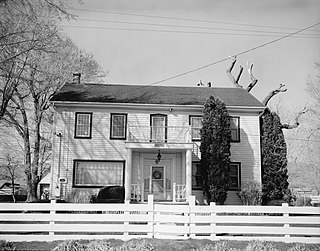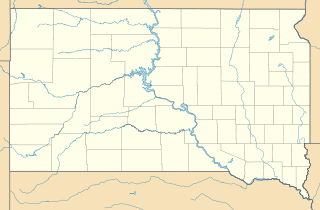
The Marlette Lake Water System was created to provide water for the silver mining boom in Virginia City, Nevada. These structures are now listed as a National Historic Civil Engineering Landmark by the American Society of Civil Engineers, and are also listed on the National Register of Historic Places. The listed area included two contributing buildings and 12 contributing structures on 135.4 acres (54.8 ha). It has also been known historically as the Virginia and Gold Hill Water Company Water System.

Goldfield Historic District is a historic district located in the center of Goldfield, Esmeralda County, Nevada, United States.

Walking Box Ranch, 7 mi (11 km) west of Searchlight, Nevada in the Mojave Desert, was founded in 1931 by the actors Rex Bell and Clara Bow as a working 400,000 acres (160,000 ha) ranch. The ranch covered 160 acres (65 ha) at the time it was listed on the National Register of Historic Places on January 30, 2009. The ranch includes four buildings and is owned by the Bureau of Land Management (BLM).

The South Main and Washington Streets Historic District — 68-139 Washington St. and 2-24 South Main St. is a historic district in South Norwalk, Connecticut. The 110-acre (45 ha) district encompasses 35 buildings and two other structures. Varied architectural styles from the late 19th and early 20th centuries include Romanesque Revival, Second Empire, and Italianate architecture. Half of the area first became part of the National Register of Historic Places in 1977. The district was increased in 1985 with the addition of nine buildings on 2.5 acres (1.0 ha) and again in 1999, with another 10 buildings on 3 acres (1.2 ha), roughly along North Main Street from Washington Street to Ann Street.

The Twaddle-Pedroli Ranch, also known as the Jackson-Harp Ranch, Rand Property and the Wilson Commons Ranch, was purchased by John Twaddle in 1869 for $5,000. The ranch, several miles to the north of Franktown, Nevada and adjacent to the Bowers Mansion, was then known as the Sturtevant Ranch. The property amounted to 630 acres (250 ha).

The Hillside Historic District in Waterbury, Connecticut is a 106-acre (43 ha) historic district that was listed on the National Register of Historic Places (NRHP) in 1987. It encompasses a residential area north of the city's central business district, and is bounded on the south by West Main Street, the west by Willow Avenue and Cliff and Frederick Streets, on the north by Buckingham Street and Woodland Terrace, and on the east by Cook Street. Developed principally over an 80-year period between 1840 and 1920, it includes a cross-section of architectural styles of the 19th and early 20th centuries. The area was a desirable neighborhood of the city for much of this time, and was home to a number of the city's elite. In 1987, it included 395 buildings deemed to contribute to the historic character of the area, and one other contributing structure. It includes the Wilby High School and the Benedict-Miller House, which are both separately listed. 32 Hillside Road, a several acre property that includes the Benedict Miller House, was the original site of The University of Connecticut's Waterbury Branch until 2003.

Ranch A, near Beulah, Wyoming, was built as a vacation retreat for newspaper publisher Moses Annenberg. The original log ranch structures in Sand Creek Canyon were designed in the rustic style by architect Ray Ewing. The principal building, a large log lodge, was built in 1932. Other buildings constructed at the time included a garage with an upstairs apartment, a barn, a hydroelectric power plant, stone entrance arches and a pump house. The lodge was furnished with Western furniture and light fixtures made by noted designer Thomas C. Molesworth. Many of these furnishings, among the first of Molesworth's career, are now the property of the state of Wyoming and are in the Wyoming State Museum.

The Joel McCrea Ranch in Thousand Oaks, California is also known as the August DuMortier Ranch. The ranch is rare surviving example of the large cattle ranches and fields of grain which once dotted the Santa Rosa and Conejo valleys in eastern Ventura County.

The Alamo Ranchhouse, near Steamboat, Nevada, is a historic "plantation style mansion" that was built in 1887. Also known as the Moffat Ranchhouse, it was listed on the National Register of Historic Places in 1979. The listing included one contributing building and one contributing structure.

The Frey Ranch, at 1140 W. Peckham Ln. near Reno, Nevada, dates from 1870, when a 240 acres (97 ha) ranch was founded. A 1 acre (0.40 ha) site of its main house, including Late Victorian architecture, survives. It was listed on the National Register of Historic Places in 1999; the listing included three contributing buildings.

The Peleg Brown Ranch, at 12945 Old Virginia Rd. in Reno, Nevada, dates from 1864. Also known as the Louis Damonte Ranch, it includes Bungalow/craftsman and Greek Revival architecture. It was listed on the National Register of Historic Places in 1994; the listing included five contributing buildings on about 4 acres (1.6 ha).

The Peavine Ranch, at 11220 N. Virginia St. in Reno, Nevada, is a historic 5.2-acre (2.1 ha) property with significance dating to 1862. It was listed on the National Register of Historic Places in 2000; the listing included five contributing buildings. It was once a stagecoach stop, but became a ghost town after a fire in 1900.

The A. T. Ranch Headquarters, in Wheeler County, Nebraska near Bartlett, Nebraska, has historic significance dating to 1906. Also known as The Headquarters and denoted as WH00-19, it was listed on the National Register of Historic Places in 1990. The listing included two contributing buildings and one other contributing structure. The main building at this rural site is a two-story house built in 1906 from concrete blocks formed at the site. The building is in Renaissance Revival style.

Barn House is the site of a summer artists' colony in Chilmark, Massachusetts, on the island of Martha's Vineyard. The property includes one of the oldest houses in Chilmark, a barn dating from the 1780s, and facilities constructed primarily during the 1920s by the Chilmark Associates to facilitate its use as a summer retreat. The property represents aspects of the island's development from its agrarian origins to a summer vacation destination.

The Flying Horseshoe Ranch was established in the Centennial Valley of southeastern Wyoming by Danish immigrant Mads Wolbol in the late 1870s. The complex of mostly log structures, about 15 of which are considered contributing structures.

The Hurricane Mills Rural Historic District, in Hurricane Mills, Tennessee is a 300 acres (120 ha) historic district which was listed on the National Register of Historic Places in 1999. The listing included five contributing buildings, four contributing structures, and two contributing sites.

The Giannonatti Ranch, in Harding County, South Dakota near Ludlow, includes 10 structures dating from around 1900. A 2 acres (0.81 ha) portion of the ranch was listed on the National Register of Historic Places in 1987.

Stewart Ranch, also known as Stewart-Hewlett Ranch, near Woodland, Utah in Wasatch and Summit counties, includes eight buildings which were separately listed on the National Register of Historic Places in 1985. The former ranch is located off Utah State Route 35. Some or all of the ranch is included in what is now the Diamond Bar X Ranch.

The University Neighborhood Historic District is a 180 acres (73 ha) historic district near the University of Utah campus in northeastern Salt Lake City, Utah, United States, that was listed on the National Register of Historic Places in 1995.

The Ferris--Hermsmeyer--Fenton, at 144 Duncan District Rd. in Sheridan, Montana, in Madison County, Montana, was listed on the National Register of Historic Places in 2008. The listing included a 160 acres (0.65 km2) area with nine contributing buildings, a contributing structure and two contributing sites.




















